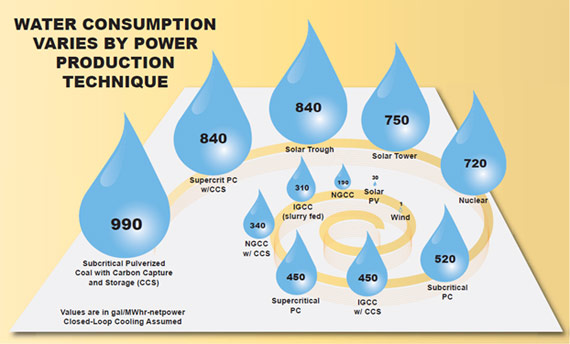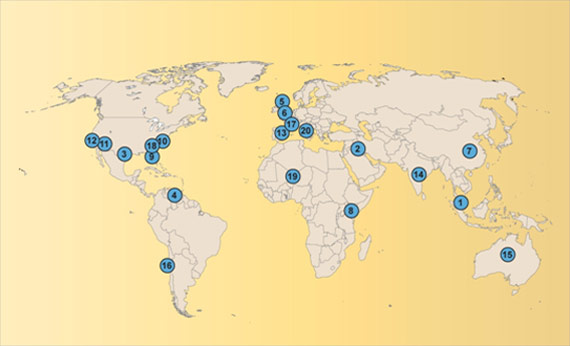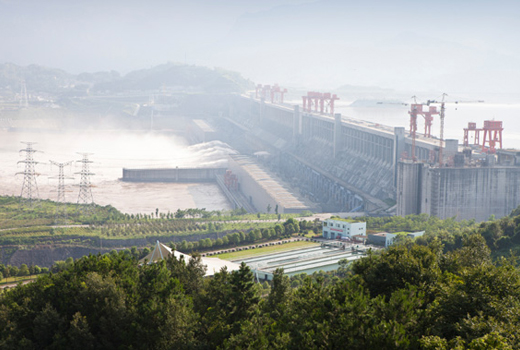CH2M HILL Seeking Energy/Water Balance
Use power or take a shower? Surely this trade-off is one everyone would like to avoid. Yet, it takes water to make energy, and it takes energy to produce, treat and transport water to users. This interrelation is often overlooked in the production of each resource. If not proactively managed together, water or energy production can have unintended negative consequences on the other. Efforts to minimize fresh water use can increase energy requirements just as efforts to minimize energy use can increase fresh water requirements. Furthermore, efforts to reduce carbon emissions from energy production can also increase water and energy requirements. Given this three-dimensional relationship, optimum selection of an energy resource, production method, carbon mitigation and water system design is a balancing act specific to local constraints.
How Much Water Does it Take to Turn on a Light Bulb?
A wide range of water intensities exist in power production, which can be optimized during selection of site location, technology, design and operation. In the power industry, large amounts of water can be required for cooling, steam generation and flue gas treatment. The major consumptive use of water is from cooling tower evaporation in thermal electric power production. While water can also be required during resource extraction, the amount is small relative to power production. In addition, the water intensity of power production increases when carbon capture and storage (CCS) efforts are utilized to reduce carbon emissions.
Water consumption by range of power sources is shown in Figure 1 with and without CCS. The consumption factors are based on a cooling system in which the effluent cooling water from the steam cycle condenser and other water is cooled in a recirculating evaporative cooling tower. The water intensity of power generation by natural gas is lower than all other energy types except for photovoltaic solar and wind energy. The addition of CCS increases water intensity by 50 percent for Integrated Gasification Combined Cycle (IGCC), 80 percent for Natural Gas Combined Cycle (NGCC), and 90 percent for Subcritical and Supercritical Pulverized Coal power plants.
Figure 1
Water Consumption Varies by Power Production Technique

Sources: NETL 2009a, US DOE 2006, Meridian 1989, AWEA.org.
Power Plant Siting and Production are Constrained by Water Issues
Water issues are becoming an increasingly critical factor in energy production operations and development plans. Aquatic species protection efforts have resulted in the proposal of new cooling regulations on both freshwater and seawater. In addition, droughts pose problems for hydroelectric power and cooling operations, and they’ve also been studied for thermal power plants (NETL, 2009b). During droughts or heat waves, surface water temperature can increase sufficiently to prevent the plant from discharging the water back into waterways in compliance with regulatory temperature limits. And, when river, lake or reservoir water levels fall near or below the plant’s water intake level, operations must be curtailed.
The need for balance between energy production, water consumption and movement to low carbon energy is exemplified in recent challenges to power plant siting and incidents at existing power production facilities. Water concerns in new operations’ permitting and in power production interruptions are prevalent worldwide. Figure 2 and Table 1 present a few examples of power plant siting and operation impacted by water issues in the past five years.
Figure 2
Power Plant Siting and Operations Impacted by Water Issues (2006-2011)

Photo Credit: CH2M Hill
Table 1
Examples of Power Plant Siting and Operations Impacted by Water Issues
| Map Number, Location and Year | Power Production Type, Water Issue and Reference |
|---|---|
| 1. Malaysia, 2011 | Coal: Plans for a new coal-fired power plant cancelled due to environmental impacts, including rise in surrounding sea temperature by four degrees Celsius as well as damage to the livelihoods of local fishermen. Reference: Environmental Development in Malaysia, February 16, 2011, (http://envdevmalaysia.wordpress.com) |
| 2. Iraq, 2011 | Hydro: Decreasing water levels at North Mosul’s dam in northern Iraq have stopped electric power generation since December 2010. Reference: Utilities-ME.com (January 30, 2011) |
| 3. Texas, 2010 | 3 Coal Plants: There is a new front in the fight over whether Texas should build more coal-fired power plants – water. The various water factions (farmers, environmentalists and growing, thirsty cities) have come together as allies against proposed coal plants across the state with battles now raging from Abilene to Corpus Christi. Their shared concern: The plants will use too much of an already stressed resource. So the unlikely allies are asking water suppliers not to sell the rights to billions of gallons to the plants. Reference: Houston Chronicle, Oct 25, 2010 (www.chron.com) |
| 4. Venezuela, 2010 |
Hydro: A drought that cut hydropower output forced draconian conservation measures. The government has announced $3bn of investment in thermal generation by 2015. Reference: The National Newspaper July 24, 2010. (www.thenational.ae) |
| 5. Scotland, 2010 | Coal: New coal fired power plant challenged because the sea around the power station could rise in temperature by up to 14C with a potentially devastating impact on the ecology of the area. Reference: The Scotsman, 6 August 2010, (thescotsman.scotsman.com) |
| 6. UK, 2010 | LNG Power: Legal challenge to a planned power station in West Wales due to concerns that the cooling system proposed for the new station could harm fish by abstracting up to 3,456,000 cubic metres of water per day and returning it bleached and up to 8C warmer. Reference: Wales Online, June 18, 2010 (walesonline.co.uk) |
| 7. China, 2010 | Hydro: In April, because of a severe drought, hydro-power-dependent Yunnan and Guizhou provinces in China’s southwest suffered power shortages. Reference: Inner Mongolia News, June 3, 2010. (www.nmgnews.com.cn) |
| 8. Kenya, 2010 | Hydro: A persistent drought caused relentless shortages of power across the country. Reference: PennEnergy, May 1, 2010 (www.pennergy.com) |
| 9. Florida, US, 2010 |
Natural gas: Power plant permit denied due to water requirements. Commissioners expressed concern about the potential impact on water supplies, rivers and springs with Seminole proposing to use up to 5 million gallons a day for cooling purposes. Reference: The Gainsville Sun, Aug 3, 2010 (www.gainsville.com) |
| 10. Virginia, US, 2009 |
Nuclear: Dominion Resources faced a legal challenge over its right to draw one million gallons of water a minute per reactor from a man-made lake it uses to cool its North Anna nuclear power plant and into which it discharges heated water. Reference: Wall Street Journal, March 26, 2009: Water Worries Shape Local Energy Decisions, Rebecca Smith |
| 11. Amargosa Valley, Nevada, US, 2009 |
Solar Trough: Power plant permit denied. The originally proposed method of cooling the power plants would have consumed 1.3 billion gallons of water a year, about 20 percent of this desert valley’s available water. Reference: New York Times, September 30, 2009: Alternative Energy Projects Stumble on a Need for Water, Todd Woody. |
| 12. Ridgecrest, California, US, 2009 |
Solar Trough: Water disputes forced Solar Millennium to abandon wet cooling for a proposed solar trough power plant in Ridgecrest, Calif., after the water district refused to supply the 815 million gallons of water a year the project would need. The company subsequently proposed to dry cool two other massive Southern California solar trough farms it wants to build in the Mojave Desert. Reference: ibid |
| 13. Southwest Europe, 2008 |
Hydro: Unusual summer drought caused decrease in hydro power generation and led to increased power generation in coal-fired power plants. Reference: E.ON Corporate Responsibility Reporting 2008 |
| 14. India, 2008 | Hydro: Power cuts ordered when monsoon rainfall was 65% less than normal. Reference: WRI, Over Heating, 2010. |
| 15. Australia, 2008 |
Coal: In Australia, a power plant and coal mine at Yallourn has been affected by too little water (drought leading to scarcity of water for cooling) and too much water (flooding leading to partial collapse of the coal mine). These conditions are also unfavourable to hydropower facilities, which rely heavily on water availability. Reference: China Light and Power Website (www.clpgroup.com) |
| 16. Chile, 2008 | Hydro: Widespread energy crisis due to severe drought. Reference: PR Newswire, May 6, 2010, (www.greentechmedia.com) |
| 17. France, 2007 | Nuclear: France was forced to import electricity from Britain to cope with a summer heatwave that has helped to put a third of its nuclear power stations out of action. Reference: The Sunday Times, July 3, 2009, (business.timesonline.co.uk) |
| 18. N. & S. Carolina, US, 2007 |
Hydro: Extreme drought conditions combined with record-breaking heat have resulted in the need for mandatory water restrictions and reductions in hydroelectric generation. Reference: Duke Company website (www.duke-energy.com) |
| 19. West Africa, 2007 |
Hydro: In Kenya, Tanzania, Uganda and parts of West Africa, drought has shrunk rivers and slashed the generating capacity of hydroelectric dams. Drought in Ghana impacted gold and aluminum production and set off blackouts in Togo and Benin, which buy power from Ghana. Reference: The New York Times, July 29, 2009, (www.nytimes.com) |
| 20. Italy, 2006 | Nuclear: Enel’s electricity plants based on the river Po (across northern Italy) suffered from the drought, which has dried up part of its course. Reference: La Republica, 16 July 2006 |
The Trends are not our Friends
While water availability is impacting the power industry now, three trends are projected to cause increased water impacts in the future:
- Population growth will decrease per capita availability;
- Energy demand will increase as developing countries industrialize and improve their standard of living; and
- Projected impacts of climate changes will impact water availability.
About 40 percent of the world lives in river basins with some form of water scarcity: 1.2 billion people experience physical water scarcity while another 1.6 billion experience economic water scarcity where human capacity or financial resources are likely insufficient to develop adequate water resources (UN MDG Report, 2008). Projected population growth to 8.1 billion by 2030 and 9 billion by 2050 will further strain water supplies as demand for water increases for personal use, sanitation, energy production and food production. Water use has grown at more than twice the population rate during the past century and is predicted to increase as the world’s population continues to industrialize. Research suggests a 60 percent increase in world energy needs in 2030 compared to 2002. Water is needed for all types of energy production, so expansion of energy supply will affect water resources (WWAP, 2009). In addition, projected climate change impacts are likely to exacerbate existing water risks and cause new ones to the energy industry. The projected impacts of climate change include:
- rising sea levels, which could penetrate fresh water aquifers and degrade water quality,
- reduced snow and glacier water storage, which affects annual supply in downstream areas, and
- increased droughts and floods in many parts of the world, both of which can negatively affect fresh water supply.
The Solution Hangs in the Balance
Optimizing and balancing complex trade-offs in the energy/water nexus requires multi-fold consideration of energy use, carbon emitted and water consumed. Significant global attention and investment has been focused on reducing carbon emissions in the past few years. Energy measurement and carbon reporting is widespread. But, if the energy/water nexus is to be balanced, water must be optimally managed with energy use and carbon emissions.
Will people be able to use power and take a shower in the future? Yes, if mankind realizes that sustainable energy production requires more than driving down carbon emissions. It requires an understanding that water is a critical component in the delicate balance to secure access to both precious resources.

© iStockphoto.com/sara_winter





























